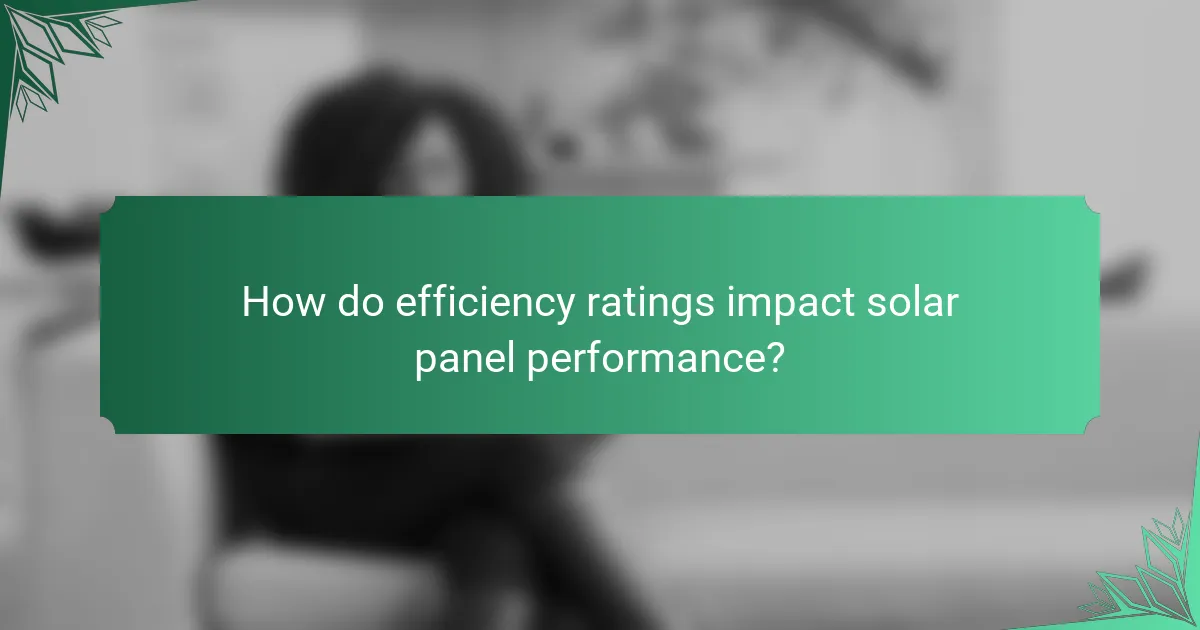
What are the different types of solar panels?
The different types of solar panels are monocrystalline, polycrystalline, and thin-film. Monocrystalline panels are made from a single crystal structure. They are known for high efficiency and space-saving design. Polycrystalline panels consist of multiple crystal structures. They are generally less expensive but also less efficient than monocrystalline. Thin-film panels are made from layers of photovoltaic material. They are lightweight and flexible but have lower efficiency rates. Each type varies in cost, efficiency, and application suitability. Monocrystalline panels typically have efficiency ratings between 15% and 22%. Polycrystalline panels usually range from 13% to 16%. Thin-film panels can have efficiency ratings from 10% to 12%.
How do monocrystalline solar panels differ from polycrystalline solar panels?
Monocrystalline solar panels differ from polycrystalline solar panels primarily in their manufacturing process and efficiency. Monocrystalline panels are made from a single crystal structure, which allows for higher efficiency rates, typically between 15% to 22%. This efficiency is due to the uniform structure that facilitates better electron movement.
In contrast, polycrystalline panels are composed of multiple crystal structures, resulting in lower efficiency rates, generally between 13% to 16%. The multiple crystals create boundaries that impede electron flow, reducing overall performance.
Additionally, monocrystalline panels tend to have a higher power output per square meter. This means they require less space for installation compared to polycrystalline panels. Monocrystalline panels also typically have a longer lifespan and better performance in low-light conditions.
Overall, the key differences lie in efficiency, manufacturing processes, space requirements, and longevity.
What are the efficiency ratings of monocrystalline solar panels?
Monocrystalline solar panels typically have efficiency ratings between 15% and 22%. This means they convert 15% to 22% of sunlight into usable electricity. The highest-rated monocrystalline panels can reach efficiencies above 22%. This efficiency is due to the high purity of silicon used in their production. Research indicates that these panels perform better in low-light conditions compared to other types. Additionally, the efficiency can be influenced by factors such as temperature and installation angle. Overall, monocrystalline solar panels are known for their superior efficiency in the solar panel market.
What are the efficiency ratings of polycrystalline solar panels?
Polycrystalline solar panels typically have efficiency ratings ranging from 15% to 22%. This efficiency is determined by the technology used in their production. Polycrystalline panels are made from multiple silicon crystals, which affects their performance. The average efficiency is around 17-18%. Higher efficiency ratings can be achieved with advanced manufacturing techniques. Research indicates that polycrystalline panels are generally less efficient than monocrystalline panels. However, they are often more cost-effective. This balance between cost and efficiency makes them a popular choice for many consumers.
What are thin-film solar panels and how do they operate?
Thin-film solar panels are a type of photovoltaic technology that utilizes layers of semiconductor materials. These materials are deposited on a substrate to create solar cells. Common materials include cadmium telluride, amorphous silicon, and copper indium gallium selenide.
Thin-film panels are lightweight and flexible, allowing for diverse applications. They operate by absorbing sunlight and converting it into electricity through the photovoltaic effect. The process begins when sunlight excites electrons in the semiconductor material. This creates an electric current as the electrons move through the material.
Thin-film solar panels typically have lower efficiency ratings compared to traditional silicon-based panels. Their efficiency ranges from 10% to 12%, while crystalline silicon panels can achieve efficiencies above 20%. However, thin-film panels perform better in low-light conditions and high temperatures. This makes them suitable for specific environments where traditional panels may underperform.
What are the efficiency ratings of thin-film solar panels?
Thin-film solar panels typically have efficiency ratings ranging from 10% to 12%. These ratings can vary based on the specific technology used, such as cadmium telluride (CdTe) or amorphous silicon (a-Si). For instance, CdTe panels often achieve efficiencies around 11-12%. Amorphous silicon panels usually reach efficiencies closer to 10%. Research indicates that advancements in thin-film technology may lead to higher efficiencies in the future. The National Renewable Energy Laboratory (NREL) has reported efficiencies of up to 18% in laboratory settings for some advanced thin-film technologies.
What are the advantages and disadvantages of thin-film solar panels?
Thin-film solar panels have several advantages and disadvantages. Their primary advantage is flexibility, allowing installation on various surfaces. They are lightweight compared to other solar panel types, making them easier to transport and install. Thin-film panels generally perform better in low-light conditions and high temperatures. They also have a lower production cost due to simpler manufacturing processes.
However, thin-film solar panels have disadvantages as well. Their efficiency is typically lower than that of crystalline silicon panels, often around 10-12%. This means they require more space to produce the same amount of energy. Additionally, their lifespan is generally shorter, with many lasting around 20 years. They may also degrade faster in certain environmental conditions compared to other types.

How do efficiency ratings impact solar panel performance?
Efficiency ratings directly impact solar panel performance by indicating how effectively a panel converts sunlight into electricity. Higher efficiency ratings mean that a solar panel can produce more energy from the same amount of sunlight. For example, a panel with a 20% efficiency rating converts 20% of sunlight into electricity, whereas a 15% efficient panel converts only 15%. This difference can lead to significant variations in energy output over time.
Additionally, efficiency ratings influence the space required for installation. Higher efficiency panels require less space to generate the same amount of power compared to lower efficiency options. This is particularly important in urban areas where roof space is limited.
Moreover, efficiency ratings can affect the overall cost-effectiveness of a solar installation. Higher efficiency panels may have a higher upfront cost but can lead to greater savings on energy bills over their lifespan. Therefore, understanding efficiency ratings is crucial for optimizing solar panel performance and ensuring a good return on investment.
What factors influence the efficiency ratings of solar panels?
The efficiency ratings of solar panels are influenced by several factors. Key factors include the type of solar cells used, such as monocrystalline or polycrystalline. Monocrystalline panels typically offer higher efficiency due to their pure silicon composition. Temperature also plays a critical role; higher temperatures can reduce efficiency. The angle and orientation of the panels impact sunlight exposure, affecting energy conversion. Additionally, shading from nearby objects can significantly lower efficiency. The quality of materials and manufacturing processes also determines performance. Lastly, the age of the solar panels can influence their efficiency, as older panels may degrade over time.
How does temperature affect solar panel efficiency?
Temperature negatively affects solar panel efficiency. As temperature increases, the efficiency of solar panels typically decreases. Most solar panels operate best at cooler temperatures. For example, crystalline silicon panels can lose about 0.5% to 0.8% efficiency for each degree Celsius increase in temperature. High temperatures can lead to increased resistance within the solar cells. This resistance reduces the overall power output. Studies show that optimal performance occurs around 25 degrees Celsius. Above this temperature, performance declines significantly. Therefore, managing temperature is crucial for maximizing solar panel efficiency.
What role does shading play in solar panel efficiency?
Shading significantly reduces solar panel efficiency. When a solar panel is shaded, it produces less electricity. This occurs because the shaded areas do not generate power. Even partial shading can lead to a substantial drop in output. For instance, a 10% shaded panel can lose up to 50% of its efficiency. The impact varies based on the type of solar panel technology used. Monocrystalline panels often perform better in shaded conditions than polycrystalline panels. Additionally, the arrangement of solar cells within a panel affects how shading influences performance. Studies indicate that optimizing panel placement can mitigate shading effects.
Why is it important to consider efficiency ratings when choosing solar panels?
Efficiency ratings are crucial when selecting solar panels because they indicate how effectively a panel converts sunlight into electricity. Higher efficiency ratings mean more energy production per square foot. This is especially important for homeowners with limited roof space. For instance, a panel with a 20% efficiency rating generates more electricity than one with a 15% rating in the same area. Moreover, panels with higher efficiency can lead to lower overall installation costs. They can also provide better performance in low-light conditions. According to the National Renewable Energy Laboratory, the most efficient panels can convert over 22% of sunlight into usable energy. Therefore, considering efficiency ratings helps maximize energy output and investment return.
How do efficiency ratings relate to energy output over time?
Efficiency ratings indicate how effectively solar panels convert sunlight into usable energy. Higher efficiency ratings mean more energy output for the same amount of sunlight. Over time, energy output can be affected by factors such as panel degradation and environmental conditions. For instance, most solar panels experience about 0.5% to 1% efficiency loss per year. Therefore, a panel with a high initial efficiency rating will maintain better energy output over its lifespan. Studies show that panels rated at 20% efficiency produce significantly more energy than those rated at 15% over 25 years. This relationship highlights the importance of efficiency ratings in predicting long-term energy production.
What is the cost-benefit analysis of high-efficiency vs. low-efficiency panels?
High-efficiency solar panels generally have a higher initial cost but offer better long-term savings compared to low-efficiency panels. High-efficiency panels convert more sunlight into electricity, typically around 20-22% efficiency, while low-efficiency panels range from 15-17%. This increased efficiency means high-efficiency panels can generate more power in the same space.
Over time, the higher energy output can lead to greater savings on electricity bills. For example, a high-efficiency panel may save a homeowner approximately $1,000 more over 25 years compared to a low-efficiency panel.
Additionally, high-efficiency panels often come with longer warranties and better performance guarantees. This can enhance their overall value and reliability. In contrast, low-efficiency panels may require more frequent replacements or maintenance, increasing their long-term costs.
In summary, while high-efficiency panels have a higher upfront cost, their greater energy production and durability can result in significant savings over time.

What are the best practices for maximizing solar panel efficiency?
To maximize solar panel efficiency, ensure optimal positioning and angle. Solar panels should be installed at an angle that captures the most sunlight. This angle varies based on geographical location. Regular cleaning of the panels is essential to remove dust and debris. Accumulated dirt can reduce energy output by up to 25%. Additionally, monitor shading from trees or buildings. Even partial shading can significantly decrease performance. Using high-efficiency solar panels can also enhance energy capture. These panels convert more sunlight into electricity compared to standard models. Lastly, invest in a quality inverter to optimize energy conversion. A good inverter can improve overall system efficiency by 5-15%.
How can installation practices enhance solar panel efficiency?
Proper installation practices can significantly enhance solar panel efficiency. Correct alignment ensures maximum sunlight exposure. Panels should be positioned at an optimal angle based on geographic location. This angle can increase energy capture by up to 25%. Additionally, avoiding shading from nearby objects is crucial. Even partial shading can reduce output by 50%. Using high-quality mounting systems prevents movement and misalignment. Regular maintenance, including cleaning, also boosts efficiency. Dust and debris can block sunlight, reducing energy production. Research indicates that well-installed solar panels can achieve over 90% of their rated efficiency.
What is the importance of proper orientation and tilt for solar panels?
Proper orientation and tilt for solar panels are crucial for maximizing energy production. The angle and direction of solar panels directly influence their exposure to sunlight. Panels facing true south in the northern hemisphere receive the most sunlight throughout the day. An optimal tilt angle enhances solar radiation capture, increasing electricity generation. Studies show that a 30-degree tilt can improve efficiency by up to 25% compared to flat installations. Proper orientation and tilt also help in reducing shading effects from nearby objects. This positioning ensures panels operate at peak performance, leading to better return on investment.
How does regular maintenance affect solar panel performance?
Regular maintenance significantly enhances solar panel performance. Clean solar panels absorb more sunlight, leading to increased energy production. Dust, debris, and bird droppings can block sunlight and reduce efficiency. Studies show that dirty panels can lose up to 25% of their output. Regular inspections also identify potential issues such as wiring problems or component wear. Addressing these issues promptly prevents further damage and maintains optimal performance. Overall, consistent maintenance ensures solar panels operate at their highest efficiency.
What common mistakes should be avoided to ensure optimal solar panel efficiency?
Common mistakes to avoid for optimal solar panel efficiency include improper installation. Incorrect angles can reduce sunlight exposure. Failing to clean panels regularly leads to dirt buildup, which hampers performance. Neglecting shade from nearby trees or buildings can significantly decrease energy production. Using inadequate wiring or connections can cause energy loss. Overlooking regular maintenance checks may result in unnoticed damage. Lastly, not considering local climate conditions can impact efficiency. Each of these mistakes can lead to decreased solar energy output.
How can improper installation impact efficiency ratings?
Improper installation can significantly lower efficiency ratings of solar panels. Misalignment of panels can reduce sunlight exposure. Poor electrical connections may lead to energy losses. Inadequate sealing can cause moisture damage, affecting performance. Incorrect tilt angles can decrease energy capture throughout the day. A study by the National Renewable Energy Laboratory found that installation errors can reduce energy yield by up to 30%. This illustrates the importance of proper installation for optimal efficiency ratings.
What are the effects of neglecting maintenance on solar panels?
Neglecting maintenance on solar panels leads to reduced efficiency and increased degradation. Dust, dirt, and debris accumulate on the surface, obstructing sunlight absorption. This obstruction can decrease energy production by up to 25%. Additionally, lack of maintenance may cause physical damage to components. For instance, cracked or broken panels can result from environmental stressors. Over time, this damage can necessitate costly repairs or replacements. Regular maintenance ensures optimal performance and longevity of solar panels. Studies show that well-maintained solar systems have a 10-20% higher efficiency compared to neglected ones.
The main entity of the article is solar panels, which are categorized into three types: monocrystalline, polycrystalline, and thin-film. Each type is analyzed based on efficiency ratings, manufacturing processes, and suitability for various applications. Monocrystalline panels are noted for their high efficiency (15%-22%), while polycrystalline panels range from 13% to 16%, and thin-film panels typically achieve 10% to 12%. The article also discusses factors influencing efficiency, such as temperature, shading, and installation practices, providing a comprehensive overview of how these elements impact solar panel performance and overall energy output.